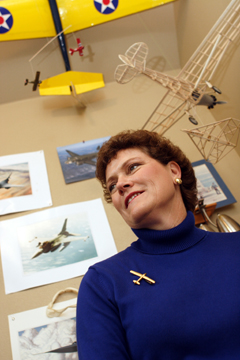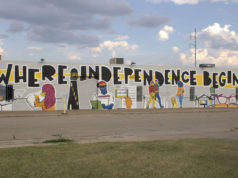 It was April 21, 2003, ten days after the Bush administration’s “shock and awe” air war against Iraq had ended. Much of Baghdad was in ruins. The ground war was raging north of the ancient capital, and the country’s oil wells were burning out of control in the south. Air Force Col. Kim Olson was on her first inspection tour of Baghdad with her boss, retired U.S. Army Lt. Gen. Jay Garner, who had been called back into service by Defense Secretary Donald Rumsfeld to head up the Office of Reconstruction and Humanitarian Assistance in Iraq. Garner had tapped Olson, then in the Pentagon comptroller’s office, to be his executive officer. They were walking through a bombed-out but still-operating hospital, when the woman pulled Olson aside. The aging nurse, “glancing fearfully around,” quickly whispered her desperate plea for help into the ear of the only woman in the general’s party. Within minutes, a generator would be on its way. The water trucks and medicines would come next. And, of course, the wounded and dying would continue to fill the rubble-strewn halls.
It was April 21, 2003, ten days after the Bush administration’s “shock and awe” air war against Iraq had ended. Much of Baghdad was in ruins. The ground war was raging north of the ancient capital, and the country’s oil wells were burning out of control in the south. Air Force Col. Kim Olson was on her first inspection tour of Baghdad with her boss, retired U.S. Army Lt. Gen. Jay Garner, who had been called back into service by Defense Secretary Donald Rumsfeld to head up the Office of Reconstruction and Humanitarian Assistance in Iraq. Garner had tapped Olson, then in the Pentagon comptroller’s office, to be his executive officer. They were walking through a bombed-out but still-operating hospital, when the woman pulled Olson aside. The aging nurse, “glancing fearfully around,” quickly whispered her desperate plea for help into the ear of the only woman in the general’s party. Within minutes, a generator would be on its way. The water trucks and medicines would come next. And, of course, the wounded and dying would continue to fill the rubble-strewn halls.
Olson, now retired and living in Weatherford with her husband and two children, recounts the incident in the first chapter of her gripping book, Iraq and Back, Inside the War to Win the Peace. She’d been in Baghdad only an hour, she wrote, but already she was seeing the “destruction and desolation … anger and despair” that would define Iraq for her and Garner as they began what she now calls their “mission improbable”: rebuilding Iraq’s infrastructure, delivering humanitarian aid, and laying the foundation for a democratic government. Garner, Olson, and the rest of the reconstruction agency were only 100 days into what they believed was a slow but sure accomplishment of that task when Garner was abruptly replaced by a civilian, Paul Bremer, a former senior director of Henry Kissinger’s international consulting firm. Garner said that Rumsfeld told him that the move had always been part of the plan — but if so, the general had not been privy to it.
Olson, now 49, began her book in July 2003, as soon as she got back from Iraq — and while the military bureaucracy was trying to end her career. “I had to get it all out of my head. … All of us have an Iraq in our life; it’s the coming back part that’s important,” she said. “The question now is, can the military ‘come back’ from Iraq; can the nation come back?” The book recounts what happened during her time in Iraq and also Olson’s own dogged journey through an often unfriendly male-dominated military establishment as one of the Air Force’s first generation of female jet pilots. She rose in the ranks to become a command pilot with more than 3,700 hours of flying time in six different types of aircraft.
“My story is a woman’s story,” Olson said recently as she ate pancakes and eggs in a crowded blue-collar café on Fort Worth’s far West Side. These days, when she’s not on the lecture circuit, she spends her time volunteering at the Tarrant County veterans’ health clinic and advocating for better care for the wounded returning from what she calls that “disastrous” war. As the lone female in his inner circle, Olson was invaluable in Iraq in helping “win the people’s trust,” Garner told Fort Worth Weekly. In the foreword to her book, he wrote that Olsen was tough but that she never lost “a compassion that embraced the religious, ethnic, and tribal diversities of the hundreds of people we encountered daily.”
Observers believe that Garner was removed by the Bush administration because of his distrust of Ahmed Chalabi, the Iraqi exile leader. Chalabi, in his efforts to promote the invasion, had been passing along to the American government what later proved to be erroneous intelligence. After Baghdad fell, Chalabi wanted control of the Iraqi government to be turned over to him. Garner nixed the idea. “I thought he was a thug,” he told author Thomas Ricks, whose book Fiasco has been called the definitive account of what went wrong in the Iraq invasion aftermath. But Chalabi had powerful friends in Bush’s cabinet in those early days, and he worked hard to undercut Garner’s authority. Garner also butted heads with the White House over who should make the decisions on the reconstruction of Iraq and what to do with the country’s oil assets. Garner thought it should be the Iraqis and pushed for elections within 90 days after the fall and for the U.S. to pull its troops out of the cities to a desert base. “It’s their country and their oil,” he told one interviewer.
But that was not what the Bush administration wanted to hear, Olson said. “Great leaders always have in their inner circle those who aren’t afraid to tell the emperor he’s naked,” she said. “This administration is too insecure for that.” Garner’s removal was a fatal turning point for Iraq, she said. “What we were doing was working.” His was a classic counter-insurgency approach, she and other writers have said: Garner reached out to the populace in person, ran from town to village to learn about needs from local civic and religious leaders, pulled every string he could to get their electricity on, make the water drinkable, bring in medicines and books, make the schools safe, get the pensioners paid and the able-bodied back to work, and was working with tribal leaders to set up an interim government. “He was trusted, because once he gave his word, he was going to make it happen,” Olson said. “He understood Iraq, the culture, the religion, and the immense value in allowing the men to save face.”
When the man in that culture is humiliated in front of his family, “he will kill those who humiliated him,” Olson said, and that endless cycle of retaliation is being perpetuated by U.S. policies — by “the midnight patrols, the indiscriminate breaking into people’s private places, especially the Muslim bedroom.” Garner said Olson brought her perspective as a woman to understanding the Iraqi people’s needs. An example was Umn Qasr, a once-prosperous seaport town that was almost completely shut down, first by Saddam’s draining of the nearby wetlands, which caused the harbor to silt up, and then by the war. “When [Garner] toured the port, I thought of their medical system,” she said. “When [he] asked about their school sports equipment, I wanted to know about the books and qualified teachers.” And everywhere she went in Iraq, she saw her own two kids in the haunted eyes of the country’s impoverished children. The children had “no food, no water, no future” — but Olson thought that the U.S., under Garner’s plan, was about to change all that.
When Bremer came in, however, he quashed most, if not all, of her and Garner’s initiatives, Olson said. Bremer “was a hard-working guy, but he never understood that part of the world.” Back in the U.S., Olson battled exhaustion and post-traumatic shock from the 18-hour days she’d put in as Garner’s executive officer. During that time, she’d been the target of assassins’ bullets, barely missed being blown up in a truck convoy, and sat by Garner’s side as they listened to Iraqi leaders warn of the coming insurgency. But now she was also battling her own superiors. She was charged with violating the government ethics code while in Iraq by helping her and Garner’s non-military bodyguards (eight South Africans working for a London-based private contractor) set up their own security and police-training company, even though, as it was later proven, she acted only as an unpaid advisor and did not profit in any way.
An angry Garner wrote in Olson’s defense that the charges were based on “fallacious allegations, undocumented evidence … and poor senior leadership. … She is a thoroughbred, and I ran her legs off. But the Air Force broke her heart.” The ethics charge, which carried a possible five-year prison sentence, was dismissed, but only after Olson spent $70,000 to defend herself. A charge of conduct unbecoming an officer was sustained; she received a reprimand and retired. “It was time for me to go,” she said. Garner, a veteran of two tours in Vietnam and the commanding general in Northern Iraq during Desert Storm, told the Weekly that Olson was never able to find out all of the charges against her or where they came from. He asked the Air Force investigators to allow him to write a letter on her behalf to be put into the record, but never received a reply. “On this one, the Air Force should be investigated, not Kim,” he said.
Out of the Air Force, Olson joined her family in Weatherford, not far from her husband’s hometown of Mineral Wells. She finished her book, a no-holds-barred account of what she sees as this administration’s badly botched handling of the aftermath of the invasion and the tragic results of its misunderstanding of the Iraqi culture. These days she is lobbying for a speedy groundbreaking of the new veterans’ clinic and hospital that’s planned in Fort Worth near the Tarrant County College South Campus. “Fort Worth has a clinic now that in no way can take on the demand for care that’s about to explode here and across the country. We are about to be overwhelmed with the wounded from this war,” she said. “This nation has an obligation to these men and women, and will have for the rest of their lives.” Garner has retired to Florida, where he lectures and serves on several organizations’ boards. While he supported the idea of removing Saddam Hussein from his roost as dictator in Iraq, Garner said, he believes the timing was wrong. “We still hadn’t completed the job in Afghanistan. And Saddam was being contained,” he said. Still, he has no regrets about his time in Iraq — “every day was rewarding,” he said. And what would have happened had he been allowed to complete his plans for the country’s recovery? He paused before answering. “We’ll never know the answer to that one, will we?”











